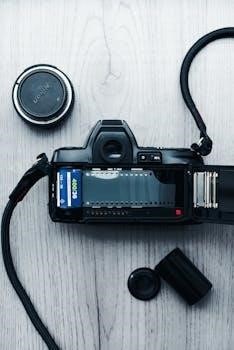nikon d610 manual english

Nikon D610 Manual⁚ A Comprehensive Guide
This guide serves as a thorough resource for mastering your Nikon D610 DSLR camera․ It provides insights into the camera’s features‚ settings‚ and controls‚ helping you to fully utilize its capabilities for capturing high-quality images․

The Nikon D610 is a full-frame DSLR camera renowned for its impressive 24․3 megapixel sensor‚ delivering exceptional image quality and detail․ This camera is a popular choice among enthusiasts and professionals alike‚ offering a robust build and a wide array of features․ It is compatible with a wide range of Nikon lenses‚ enhancing its versatility․ The D610 provides users with the capability to capture stunning photos and videos‚ catering to various photographic styles․ It’s a reliable and versatile option for those seeking a dependable camera body․ Its user-friendly interface and ergonomic design further contribute to its appeal․ With its combination of performance and practicality‚ the D610 stands out as a reliable tool for diverse photographic needs․ The camera’s excellent image resolution and dynamic range are well-suited for both everyday shooting and more demanding projects․ Its compatibility with 35mm format lenses expands creative possibilities‚ making it an outstanding choice for photographers of all skill levels․
Downloading the Official User Manual
Accessing the official user manual for your Nikon D610 is essential for maximizing its potential․ Nikon provides downloadable manuals in PDF format on their official support website․ These manuals offer comprehensive guidance on all aspects of the camera․ To obtain the manual‚ navigate to the Nikon support section‚ locate the D610 product page‚ and find the manuals section․ Select the appropriate language‚ and download the PDF file․ The user manual is available in multiple languages‚ including English․ This resource is invaluable for understanding the camera’s features‚ settings‚ and operation․ You can also find user manuals on third-party websites‚ although it’s recommended to use the official Nikon source․ The manual is an extensive guide‚ often spanning hundreds of pages‚ and can be easily viewed on various devices․ It allows users to become proficient with the camera’s capabilities and troubleshoot common issues․ The PDF format allows for easy searching and referencing of specific information․ Always ensure you have the most up-to-date version of the manual for the most accurate guidance․
Understanding Camera Menus and Settings
The Nikon D610 boasts an intricate menu system designed to provide extensive control over camera functions․ Familiarizing yourself with these menus is crucial for maximizing the camera’s potential․ The menu is divided into categories such as Playback‚ Shooting‚ Custom Settings‚ Setup‚ Retouch‚ and My Menu․ Each section houses various settings‚ allowing you to fine-tune your images and shooting experience․ The Playback menu allows managing and reviewing captured images․ The Shooting menu contains options for image quality‚ size‚ ISO‚ and white balance․ The Custom Settings menu provides personalized configurations for functions like button assignments and autofocus behavior․ The Setup menu includes settings for date‚ time‚ language‚ and firmware updates․ The Retouch menu allows for in-camera image editing․ My Menu enables you to create a customized menu of your most frequently used settings․ Navigating these menus involves using the command dials and multi-selector; The camera’s LCD screen displays the menu options‚ and the user manual offers detailed explanations of each setting․ Consistent exploration of the menus will help you gain a deeper understanding of your camera’s capabilities and optimize your photography․
Navigating the Command Dials
The Nikon D610 utilizes two command dials‚ located on the front and rear of the camera body‚ to adjust numerous settings quickly and efficiently․ These dials are essential tools for controlling exposure‚ navigating menus‚ and changing various camera parameters․ The front command dial‚ typically positioned near the shutter button‚ is primarily used for adjusting aperture in aperture-priority mode (A) and shutter speed in shutter-priority mode (S)․ In manual mode (M)‚ it controls the shutter speed․ The rear command dial‚ situated near the thumb rest‚ primarily adjusts the aperture in manual mode and is also used for navigating through the menu system․ In conjunction with the multi-selector‚ the rear dial allows quick menu selection and setting adjustments․ By combining these dials‚ photographers can manipulate exposure and other settings with great ease․ The dials are often used together to adjust specific parameters‚ such as exposure compensation․ Understanding their individual functions and how they work in tandem is key to unlocking the D610’s full potential․ Practice using the command dials to become comfortable with making quick adjustments while shooting‚ enhancing your overall photographic experience․
Exposure Modes and Settings
The Nikon D610 offers a variety of exposure modes to cater to different shooting scenarios and levels of user control․ These modes‚ accessible via the mode dial on the top of the camera‚ include Programmed Auto (P)‚ Shutter-Priority Auto (S)‚ Aperture-Priority Auto (A)‚ and Manual (M)․ In Programmed Auto‚ the camera automatically sets both aperture and shutter speed‚ allowing the photographer to focus on composition․ Shutter-Priority Auto enables the user to select the shutter speed‚ while the camera adjusts the aperture to achieve correct exposure․ Aperture-Priority Auto allows the user to set the aperture‚ while the camera determines the appropriate shutter speed․ In Manual mode‚ the photographer has complete control over both aperture and shutter speed․ Additionally‚ the D610 features Bulb mode for very long exposures․ Exposure compensation settings‚ accessible through dedicated buttons and the command dials‚ allow for fine-tuning of exposure in P‚ S‚ and A modes․ Understanding these exposure modes is vital for achieving the desired results in various lighting conditions and creative styles․ The D610 also has a metering system to help determine correct exposure․
Focus Modes and Options
The Nikon D610 provides several autofocus modes and options to ensure sharp and accurate focusing in various shooting conditions․ The primary focus modes include Single-servo AF (AF-S)‚ Continuous-servo AF (AF-C)‚ and Manual focus (M)․ AF-S is ideal for stationary subjects‚ focusing once when the shutter-release button is pressed halfway․ AF-C is used for moving subjects‚ continuously adjusting focus as the subject moves․ Manual focus allows the user to focus the lens manually․ The D610 offers multiple AF-area modes․ Single-point AF allows the user to select a single focus point․ Dynamic-area AF uses multiple focus points to track a moving subject․ Auto-area AF allows the camera to select the focus point automatically․ 3D-tracking uses color information to track subjects․ There is also an option for face-priority AF in live view․ The focus mode and AF-area mode can be selected using the focus selector switch and the command dials․ Understanding these different focus options allows photographers to capture sharp and detailed images‚ regardless of the subject’s movement or the shooting environment․ The D610 also has focus lock capabilities․

Using Nikon Lenses with the D610
The Nikon D610 is compatible with a wide range of Nikon F-mount lenses‚ providing photographers with extensive creative options․ The camera works seamlessly with both FX and DX format lenses․ FX lenses are designed for full-frame sensors like the one in the D610‚ providing the intended field of view and image quality․ DX lenses‚ designed for crop sensor cameras‚ can also be used on the D610․ When a DX lens is attached‚ the camera automatically switches to DX crop mode‚ reducing the image area and effectively increasing the focal length․ This allows photographers to use older or specialized DX lenses․ When using lenses‚ it’s essential to ensure proper mounting and alignment․ The lens should be attached by aligning the mounting index on the lens with the one on the camera body‚ and then rotating the lens until it clicks into place․ It is also essential to check the lens’s focus and aperture settings․ Many Nikon lenses feature aperture rings‚ which need to be set to the smallest aperture (largest f-number) for proper electronic control by the camera․ The D610’s lens compatibility extends to various types‚ including zoom lenses‚ prime lenses‚ and macro lenses․ This allows photographers to capture everything from wide landscapes to detailed close-ups․
Troubleshooting Common Issues

Encountering issues with your Nikon D610 can be frustrating‚ but many common problems have straightforward solutions․ If the camera fails to power on‚ the first step is to check the battery․ Ensure it is fully charged and correctly inserted into the compartment․ Try using a different‚ known-good battery if available․ Also‚ inspect the battery contacts for any signs of corrosion or damage that could interfere with power delivery․ Should the camera’s LCD screen not display images properly‚ try adjusting the brightness․ If the screen is blank or appears distorted‚ it may be necessary to reset the camera to its factory settings․ Problems with image focus can often be traced to incorrect focus mode selection․ Verify that the correct focus mode is enabled for the intended subject‚ whether it is single-servo for static subjects or continuous-servo for moving ones․ If the autofocus is not working‚ ensure that the lens is properly mounted‚ and the focus mode switch on the lens and camera are correctly set․ Should the D610 fail to save images‚ check that the SD card is properly inserted and not write-protected․ If the SD card is full‚ delete unwanted images or use a new card․ Error messages on the LCD screen are useful‚ and consulting the manual is advised․
Resetting the D610 to Factory Settings
Restoring your Nikon D610 to its factory settings can be a useful troubleshooting step or a way to start fresh with your camera configuration․ The process is straightforward and can resolve many issues caused by inadvertently altered settings․ To initiate the reset‚ begin by accessing the camera’s menu system‚ typically done by pressing the ‘Menu’ button on the rear of the camera․ Navigate through the menu options until you locate the ‘Custom Settings Menu’ or a similar section containing reset options․ Within this menu‚ you will find the option to ‘Reset custom settings’․ Selecting this option will prompt the camera to confirm your choice‚ as this action will revert many camera settings to their defaults․ It is important to remember that this reset usually does not affect image files stored on the memory card; it focuses on the camera’s configuration parameters․ After selecting the reset option and confirming your choice‚ the D610 will initiate the process and the camera will be ready for use with all settings reverted to their original state․ This can be particularly useful if you’ve inherited a used camera or if you are experimenting with different settings and wish to have a clean slate․
Firmware Updates for the Nikon D610
Keeping your Nikon D610’s firmware up-to-date is essential for optimal performance and access to the latest features and bug fixes․ Nikon regularly releases firmware updates to enhance the functionality of their cameras‚ and the D610 is no exception․ To check if a new firmware version is available for your camera‚ visit the official Nikon support website․ Typically‚ you will find a dedicated section for downloads‚ where you can search for the D610․ If a newer firmware version is available‚ download the file to your computer․ Once downloaded‚ you will need to transfer the firmware file to a memory card that is compatible with your D610․ Ensure the memory card is properly formatted before transferring the file․ Insert the memory card with the firmware file into the camera and power it on․ The D610 will typically detect the firmware file‚ and prompt you to begin the update․ Follow the on-screen instructions carefully during the update process․ It’s crucial to not power off the camera or remove the memory card during this time‚ as it could damage your camera․ After the update is complete‚ the camera will restart and be ready to use with the updated firmware․